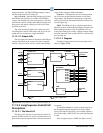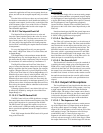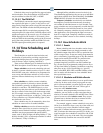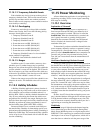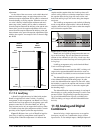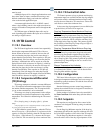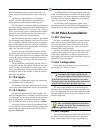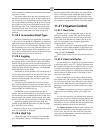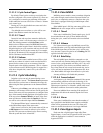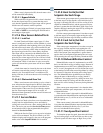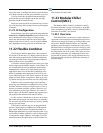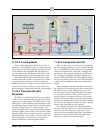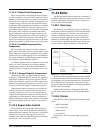
TD Control Software Overview • 11-49
must be used.
A Multiple Input cell is a simple application that reads
data values from its inputs, combines them using a user-
defined combination strategy, and sends the combined
value to the desired application input.
A common application for this is in HVAC control,
where a single heating control value might come from an
average of a number of temperature sensors throughout the
building.
Two different types of Multiple Input cells may be
used, depending upon whether the inputs to be combined
are analog or digital sources.
11.19 TD Control
11.19.1 Overview
The TD Control application controls fans sequentially
based on the temperature differential (TD) of the con
-
denser. When an increase is called for, the next fan will
turn on when the time since the last fan state change is
greater than the Fan On Delay Time setpoint (or will turn
on immediately if the last change was more than the Fan
On Delay). Additional fans will be staged on at Fan On
Delay intervals while an increase in capacity is called for.
When a decrease is called for, the next fan will stage off
when the time since the last fan state change is greater
than the Fan Off Delay Time setpoint (or will turn off
immediately if the last change was more than Fan Off
Delay). Additional fans will be staged off at Fan Off Delay
intervals while a decrease in capacity is called for.
11.19.2 Temperature Differential
(TD) Strategy
TD strategy attempts to maintain a constant difference
(i.e., TD setpoint) between the temperature of the refriger
-
ant and the ambient temperature. The TD setpoint allows
you to set the constant that is to be maintained.
TD strategy uses drop leg temperature for the refriger-
ant temperature and plenum temperature for the ambient
temperature. The formula for determining the TD control
value is:
TD = (dropleg temp) + (dropleg offset*) - plenum
temp.
* DropLeg Offset is a user-configured parameter to allow fine-tun-
ing of the drop leg temperature measurement.
In TD condenser control operation, when the TD rises
above TD setpoint + (TD deadband / 2), an increase in fan
capacity is called for. Similarly, when the TD drops below
TD setpoint - (TD deadband / 2), a decrease in fan capac
-
ity is called for. TD can control up to four condenser fans.
11.19.3 TD Control Fail-Safes
TD Control operates as long as plenum and drop leg
temperature inputs are available and the drop leg tempera
-
ture remains within a minimum/maximum range config-
ured by the user. Otherwise, TD control uses various fail-
safe modes to control the condenser fans.
In the event drop leg temperature is not available (due
to probe failure), all fans will be staged on.
Drop Leg Temperature Above Maximum Drop Leg
Setpoint
If the Drop Leg temperature (Drop Leg Temp) rises
above the maximum drop leg temperature setpoint (Drop
Leg Max), an increase will be called for until Drop Leg
Temp drops below Drop Leg Max. This protects against
the possibility of the Drop Leg Temp rising too high as a
result of high plenum temperature.
Drop Leg Temperature Below Minimum Drop Leg
Setpoint
If the Drop Leg temperature drops below the mini-
mum drop leg temperature setpoint (Drop Leg Min) a
decrease will be called for until Drop Leg Temp rises
above Drop Leg Min. This protects against the possibility
of the Drop Leg Temp falling too low as a result of low
plenum temperature.
Plenum Temperature Not Available
If plenum temperature is not available (due to probe
or communication failure), control will be based on the
Drop Leg Min and Max setpoints.
11.19.4 Configuration
TD Control allows the user to operate a condenser at
its designed temperature differential and saves energy by
maintaining optimal condenser TD with the least amount
of fans on as possible.
Standard discharge pressure control may attempt to
operate the condenser below its designed TD and turn on
more fans than necessary.
Set the number of condenser fans to be controlled in
the Num Cond Fans field under Setup (4 is the default
value).
11.19.5 Setpoints
TD setpoints are configured to allow control of the
condenser at its designed TD during swings in ambient
temperature.
For the Drop Leg Minimum setpoint, if the drop leg
temperature falls below this setpoint, condenser fans will
be cycled OFF regardless of the value of the TD setpoint.
For the Drop Leg Maximum setpoint, it is the maxi-
mum allowable value of the drop leg temperature. If the



